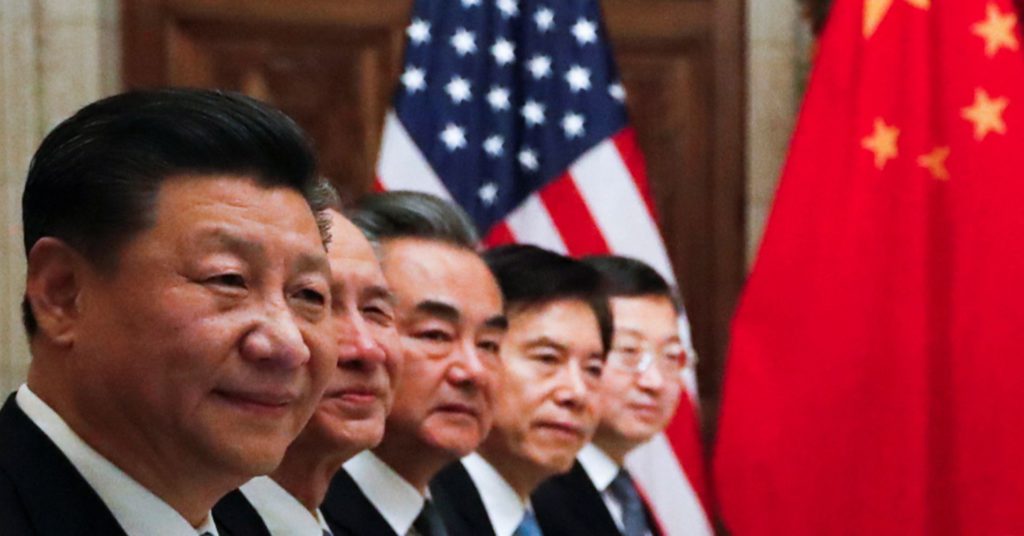What Beijing and its state-controlled media are saying about the Trump-Xi deal

Kevin Lemarque | Reuters Chinese President Xi Jinping and members of Chinese delegation attend a working dinner with U.S. President Donald Trump after the G20 leaders summit in Buenos Aires, Argentina December 1, 2018.
BEIJING, Dec 3, 2018, CNBC. While both the U.S. and China called this weekend’s meeting on trade very successful, many Chinese-language state media left out references to a 90-day condition for both sides to agree on issues such as technology transfer, reported the CNBC.
While it’s typical for there to be some daylight between governments’ spin about bilateral meetings, a host of differences between the Chinese and the American version of events points to a potentially challenging road ahead for any negotiations.
Another apparent discrepancy come from Chinese Foreign Minister Wang Yi’s, who remarked that the two countries will work toward eliminating tariffs. A White House Press Secretary statement posted online, for its part, did not include that point.
The White House did not immediately respond to a CNBC request for comment outside of U.S. business hours. The Chinese Ministry of Foreign Affairs did not immediately respond to a faxed request for comment ahead of a daily afternoon press conference.
U.S. President Donald Trump and Chinese President Xi Jinping met over a dinner during the G-20 summit in Argentina after months of increasing trade tensions between the two countries. The U.S. has imposed tariffs on $250 billion worth of Chinese goods, while Beijing has retaliated with duties on $110 billion of U.S. goods.
The White House’s latest round of tariffs on $200 billion goods was set to rise to 25 percent from 10 percent on Jan. 1, 2019, but Trump agreed at the G-20 meeting not to do so.
The catch is, however, that Xi and Trump must find resolution on “forced technology transfer, intellectual property protection, non-tariff barriers, cyber intrusions and cyber theft, services and agriculture” within 90 days, according to the White House press secretary’s statement.
That gives the leaders until early March — past Christmas, New Year’s and Chinese New Year — to find a way to keep tariffs from rising.
However, official online statements about Chinese Foreign Minister Wang Yi’s briefing on the meeting did not discuss the technology transfers or the 90-day condition.
The timeframe and details on areas of disagreement also did not appear in online reports from China’s state news agency Xinhua, People’s Daily — the official Communist Party paper — and CGTN — the English-language version of state broadcaster CCTV.
The articles did note the U.S. and China agreed to work towards mutual benefits, and generally indicated Beijing would increase purchases of U.S. goods. The state media also said the two parties discussed North Korea denuclearization. The Chinese press also said Trump upheld a “One-China Policy” regarding Taiwan — something not mentioned in the White House statement.
On top of that, Trump tweeted late Sunday evening that “China has agreed to reduce and remove tariffs on cars coming into China from the U.S. Currently the tariff is 40%.”
Prior to that Twitter post, there had not been any mention of such an agreement in Chinese sources.
Foreign Minister Wang Yi’s remarks and some articles also discussed how China would move toward controlling fentanyl, which is linked to the opioid crisis in the U.S.
Again, such a remark fell short of the second paragraph in the White House’s statement that: “President Xi, in a wonderful humanitarian gesture, has agreed to designate Fentanyl as a Controlled Substance, meaning that people selling Fentanyl to the United States will be subject to China’s maximum penalty under the law.”
In addition, Chinese state media did not mention the White House’s claim that “Xi also stated that he is open to approving the previously unapproved Qualcomm-NXP deal should it again be presented to him.”
However, English-language editorials in Global Times did note the 90-day condition, and mentions of the timeframe were scattered throughout private Chinese-language reports and social media discussion.
But WeChat users were unable to share a Chinese and English-language version of the White House Press Secretary’s statement from the U.S. embassy’s official WeChat account. The post had more than 100,000 views and 5,423 likes as of Monday morning. Users could share other embassy posts.
WeChat, developed by Chinese tech giant Tencent, did not immediately respond to a request for comment.
“The U.S. Embassy faces regular and routine blocking of social media posts in China,” according to a U.S. embassy spokesperson. “The U.S. believes the free flow of information, including citizens’ access to media, plays an important role in fostering mutual understanding.”